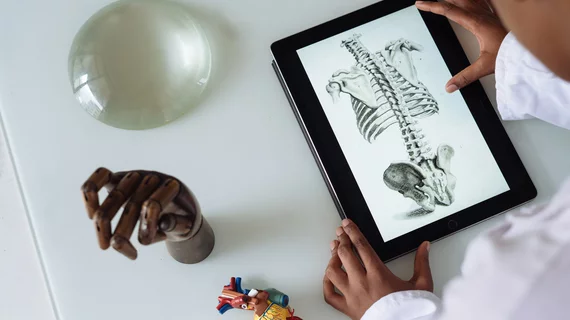Routine CT scans offer radiologists opportunity to detect costly bone problems
Routine computed tomography screening exams can be used to detect osteoporosis in older patients, new musculoskeletal imaging research suggests.
The U.S. Preventative Services Task Force recommends all women 65 years or older should be screened for osteoporosis via bone mineral density measuring. But this new study puts forth the question—why perform multiple exams when one can do the trick?
Radiologists from Mount Sinai School of Medicine led a search to assess the pooled diagnostic capability of CT for diagnosing OA using specified Hounsfield Unit thresholds. Their literature review turned up 10 studies, showing CT performed reasonably well and may be an opportunity to spot bone weakness.
“The field of radiology as a whole is becoming more interested in extracting all possible information from CT scans for indications other than screening, in other words for pursuing opportunistic screening of other organs included in the thoracic CT scans,” Yeqing Zhu, with the New York medical school’s radiology department, and colleagues explained Aug. 9 in Clinical Imaging. “And this meta-analysis provides additional assurance that evaluation of osteoporosis is possible.”
Patients included in the 10 studies all underwent CT with lumber and/or thoracic spine for various indications. HU measurements were used to spot osteoporosis while dual X-ray absorptiometry (DXA) scans—used to measure bone density—served as the reference standard.
Overall, the average area under the hierarchical summary receiver operating characteristic curve for diagnosing OA was 0.84. Computed tomography’s pooled sensitivity and specificity for diagnosing the bone condition landed at 0.83 and 0.74, respectively.
More than 80 million CTs are performed in the U.S. each year, and osteoporosis fractures remain undiagnosed and undertreated, leading to downstream healthcare costs, the authors noted.
“Therefore, we recommend radiologists use this simple measure to detect possible osteoporosis when reading chest or abdominal CT scans and refer for orthopedic specialists for follow-up with positive findings,” Zhu et al. added.
Only 10 studies were included in this analysis—a clear limitation, the authors reported. And meta-regression showed DXA criteria and scanner manufacturer significantly impacted CT’s sensitivity. Specificity also changed from machine to machine.
With this, Zhu and colleagues suggest “radiologists should be aware of the vendors of the scanners and make sure using the correct CT HU threshold values in order to have a reasonable accuracy for detecting osteoporosis.”

